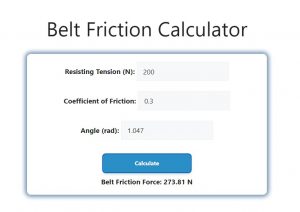About Belt Friction Calculator (Formula)
In mechanical systems, understanding belt friction is crucial for ensuring efficient power transmission. The Belt Friction Calculator is a valuable tool that helps engineers and technicians determine the friction force exerted by a belt under various conditions. Belt friction plays a vital role in the operation of pulleys, conveyors, and various machinery. By accurately calculating belt friction, one can optimize performance and prevent slippage, leading to improved operational efficiency. This article will discuss the formula used, guide you on how to use the calculator, provide a practical example, and answer frequently asked questions.
Formula
The formula for calculating belt friction force is:
Belt Friction Force (BF) = Resisting Tension (RT) * e^(μ * θ).
How to Use
- Identify the Parameters: Gather the necessary data:
- Resisting tension (RT) in pounds or newtons.
- Coefficient of friction (μ) for the belt material.
- Angle of wrap (θ) in radians.
- Input the Values: Enter the values for RT, μ, and θ into the calculator.
- Perform the Calculation: The calculator will apply the formula to compute the belt friction force.
- Analyze the Results: Review the output to understand the friction force generated by the belt, which can help in design and troubleshooting.
Example
Suppose you have the following values for a belt system:
- Resisting tension (RT) = 200 N
- Coefficient of friction (μ) = 0.3
- Angle of wrap (θ) = 60 degrees (which is 1.047 radians when converted).
To calculate the belt friction force, first, convert the angle to radians and then plug the values into the formula:
Belt Friction Force (BF) = 200 N * e^(0.3 * 1.047)
Belt Friction Force (BF) = 200 N * e^(0.3141)
Belt Friction Force (BF) ≈ 200 N * 1.368
Belt Friction Force (BF) ≈ 273.6 N.
In this example, the calculated belt friction force is approximately 273.6 N, indicating the force exerted by the belt in this configuration.

FAQs
- What is belt friction?
Belt friction refers to the resistance encountered by a belt when it moves over pulleys or other surfaces, affecting its ability to transmit power. - Why is belt friction important?
Understanding belt friction is crucial for ensuring that belts can effectively transmit power without slipping or failing. - What does the coefficient of friction (μ) represent?
The coefficient of friction is a measure of how much frictional force exists between two surfaces in contact, such as a belt and a pulley. - How do I determine the angle of wrap (θ)?
The angle of wrap is the angle subtended by the belt around the pulley, measured in radians. You can calculate it based on the pulley diameter and belt path. - Can I use the calculator for different belt materials?
Yes, you can input different coefficients of friction for various belt materials to determine their specific friction forces. - What units should I use for the inputs?
You can use either metric (Newtons, radians) or imperial (pounds, degrees) units, but be consistent throughout your calculations. - How can I improve belt friction in a system?
Increasing the coefficient of friction (by using better materials), ensuring proper tension, and optimizing the angle of wrap can enhance belt friction. - What happens if the belt slips?
If a belt slips, it can lead to inefficient power transmission, increased wear, and potential damage to the machinery. - Is the calculator accurate for all belt configurations?
The calculator provides estimates based on the inputs. For complex systems, consult engineering standards or perform additional testing. - What is the typical coefficient of friction for rubber belts?
Rubber belts usually have a coefficient of friction ranging from 0.3 to 0.9, depending on the surface and conditions. - Can I use this formula for flat belts only?
While the formula is primarily designed for flat belts, it can also be adapted for round belts with adjustments to the parameters. - What factors affect belt tension?
Factors include the load being transmitted, belt wear, environmental conditions, and the design of the pulley system. - How does temperature affect belt friction?
Temperature changes can alter the material properties of the belt and pulley surfaces, affecting the coefficient of friction. - What is the role of the angle of wrap in belt systems?
A larger angle of wrap increases the friction force, improving the belt’s ability to transmit power. - How often should I check belt tension and friction?
Regular inspections, especially in high-use applications, are recommended to maintain optimal performance. - Can belt lubrication affect friction?
Yes, excessive lubrication can reduce friction and lead to slippage, while insufficient lubrication can cause wear. - Is there a limit to how much tension a belt can handle?
Yes, exceeding the belt’s tension limit can lead to failure, so it’s crucial to maintain proper tension levels. - What are the common applications for belt systems?
Belt systems are widely used in conveyors, automotive engines, and various manufacturing machinery. - Can I calculate belt friction for a variable speed drive?
Yes, but additional factors may need to be considered, such as speed changes and load variations. - What should I do if the calculated friction force is too low?
If the friction force is inadequate, consider increasing the angle of wrap, improving belt tension, or changing materials.
Conclusion
The Belt Friction Calculator is an essential tool for anyone involved in the design and maintenance of belt-driven systems. By understanding and calculating belt friction, engineers can ensure that belts operate efficiently, reducing the risk of slippage and wear. This knowledge is vital for optimizing machinery performance and extending the lifespan of belt systems. Regularly using the calculator can help in making informed decisions regarding belt selection, system design, and maintenance strategies.